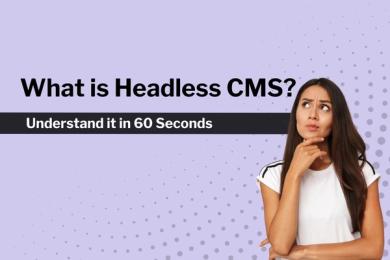What Is Headless CMS – Understand It in 1 Minute
Updated May 28, 2024
Published May 11, 2024

Have you ever wondered how people easily add, change, and manage content on their websites without needing to be tech wizards?
Usually, they use something called a CMS, or Content Management System.
However, as businesses grow and customer needs become more complex, a new approach called Headless CMS has gained popularity.
In this article, we will explain everything you need to know about what Headless CMS is, how it functions, and how it differs from traditional CMSes like WordPress.
We’ll dive into the various applications of headless content and show you how it can be used across different platforms such as websites and apps.
What is Headless CMS
A headless CMS is a type of content management system where the part that displays the content (what users see) is separate from the part where the content is organized and stored (the backend).
A headless CMS allows you to store all your content in one place and share it across any digital platform you choose. By separating the presentation layer from the backend, your content becomes more accessible. This setup makes it easier for non-tech-savvy users to handle content on their own, and for developers to build things faster, automate changes, and manage large amounts of digital content more effectively.

Why is it called Headless CMS?
A headless CMS is a content management system focused solely on the backend, designed primarily as a content storage space. The content stored can be accessed using a RESTful API or GraphQL API, allowing it to be displayed on any device.
This setup separates your content (the “body”) from the way it is displayed (the “head”), which is why it’s called “headless.”
Pros and Cons of Headless CMS
Pros
Greater Flexibility
Unlike traditional CMS systems, which can be restrictive, a headless CMS offers the flexibility to design your front-end however you like, using any style or technology that suits your business best.
Simpler Setup
The CMS tool is dedicated solely to storing content, without being overloaded with additional features only relevant to specific business users or developers.
Increased Security
The separation of the content publishing platform from the CMS database means fewer concerns about backend security problems impacting the front-end.
Effective Platform Management
A headless CMS enables marketers to efficiently manage content across all channels, ensuring a consistent and relevant experience at every user touchpoint.
Enhanced Speed
Content creators can work more efficiently as updates automatically apply across all digital platforms, speeding up content production and enabling the reuse of content.
Content Priority
Each headless CMS includes a well-defined API, allowing developers to focus more on crafting content and less on its management.
Reduced Need for Specialists
A headless CMS can help reduce costs by lowering the need for specialized personnel. While some expertise is still necessary, the overall dependency on specialists is decreased compared to traditional CMS systems.
Scalability Without Downtime
Maintenance of the backend or frontend can be conducted without any downtime, allowing for seamless optimizations or upgrades to your site.
Cons
Custom Design Requirements
Traditional CMS offers a variety of ready-made templates to simplify setup but headless CMS requires you to create your design and structure, adding to the complexity.
Broad Technical Skillset Needed
Headless CMS separates frontend development, requiring developers to be skilled in multiple programming languages and frameworks to effectively handle different parts of the system.
Challenges in Content Previewing
Without the ability to directly preview content, using a headless CMS can lead to formatting challenges. Developers must take extra steps to ensure that content appears correctly across different platforms.
Infrastructure for Content Management
Managing a headless CMS requires robust infrastructure to support and maintain the presentation aspects of your digital projects, such as websites and apps.
Higher Operational Costs
Implementing a headless CMS can be more expensive and complex than traditional systems. Costs include not just the CMS but also the development and infrastructure needed to support it.
Limited Personalization Capabilities
Since the headless CMS separates content management from content delivery, it can be difficult to gather comprehensive user data for personalized content. However, integrating BI (business intelligence) tools can help mitigate this drawback by improving content analytics.
When to Use a Headless CMS
Headless CMSs are ideal for businesses looking for a highly customizable and manageable content system without a traditional front-end website.
This is especially useful for sectors like media, entertainment, publishing, and eCommerce, as well as companies that handle extensive content for internal use. These industries benefit from the scalability, adaptability, and efficiency that headless CMSs offer.
Customized Content
Headless CMS allows for the creation of customized content tailored to different audiences, which can be distributed via emails, social media, and websites. It supports the use of tools that adapt content templates to meet specific needs.
Integration with Other Applications
Headless CMS architecture can be used to supply content to various software components such as chatbots, voice assistants, and devices connected to the Internet of Things (IoT), enhancing interaction through technology.
Web Development
Headless CMS is suitable for developing high-performance sites including static sites as well as web applications. It’s compatible with modern JavaScript frameworks such as React, Vue.js, and Angular, making it versatile for various web projects.
Versatile Content Management
Unlike traditional CMS that often focuses on web pages, a headless CMS is ideal for managing a diverse range of digital content—everything from digital displays to print materials can be managed from one central system.
E-commerce Backend Solutions
A headless CMS can manage product catalogs, track inventory, and update pricing for ecommerce platforms, enabling personalized shopping experiences across multiple channels.
Mobile App Content
For mobile applications, a headless CMS offers an excellent authoring experience and allows for content reuse across other digital platforms like websites, saving both time and resources.
Headless CMS vs Traditional CMS
Refer to this table for a quick comparison of traditional CMS versus headless CMS, focusing on essential tech features that enhance your work efficiency.
| Traditional CMS | Headless CMS | |
|---|---|---|
| Workflow | Typically follows a linear, step-by-step workflow | Supports agile and continuous integration/continuous deployment workflows |
| Hosting & Delivery | Often hosted on-premises or managed hosting | Primarily cloud-based, leveraging CDN for global distribution |
| Development Mindset | Focuses on immediate, out-of-the-box solutions | Emphasizes long-term scalability and flexibility |
| Supported Devices | Primarily web-focused | Supports a wide range of devices, including IoT and mobile |
| Reach | Limited to specific platforms (mostly web) | Broad, capable of serving content to any channel via APIs |
| Content Model | Fixed and page-oriented | Flexible and component-based, suitable for dynamic |
| Updates | Updates can be infrequent and may require downtime | Allows for real-time updates without disrupting the front end |
| Backend System | Monolithic architecture that combines front and back end | Decoupled architecture, separating the back end from the front end |
| Investment | Lower initial cost but potentially higher maintenance costs | Higher initial setup cost, lower long-term maintenance costs |
| Technical Debt | Can accumulate technical debt due to less flexibility | Minimizes technical debt by allowing updates and integrations without major overhauls |
How can you start using headless commerce?
It’s important to recognize that developers and designers usually have different skills and focus. A good headless commerce platform offers APIs and tools that let developers create consistent, brand-aligned experiences across various channels using a unified data view.
At the same time, creative teams can concentrate on enhancing the user interface and experience to boost customer engagement and increase conversions. The flexibility provided by a reliable headless platform allows developers to work quickly and independently, using their choice of API, code, tools, and any third-party integrations.
Related
Share This Post
Ada Rivers
Ada Rivers is a senior writer and marketer with a Master’s in Global Marketing. She enjoys helping businesses reach their audience. In her free time, she likes hiking, cooking, and practicing yoga.
Allow cookies
This website uses cookies to enhance the user experience and for essential analytics purposes. By continuing to use the site, you agree to our use of cookies.
